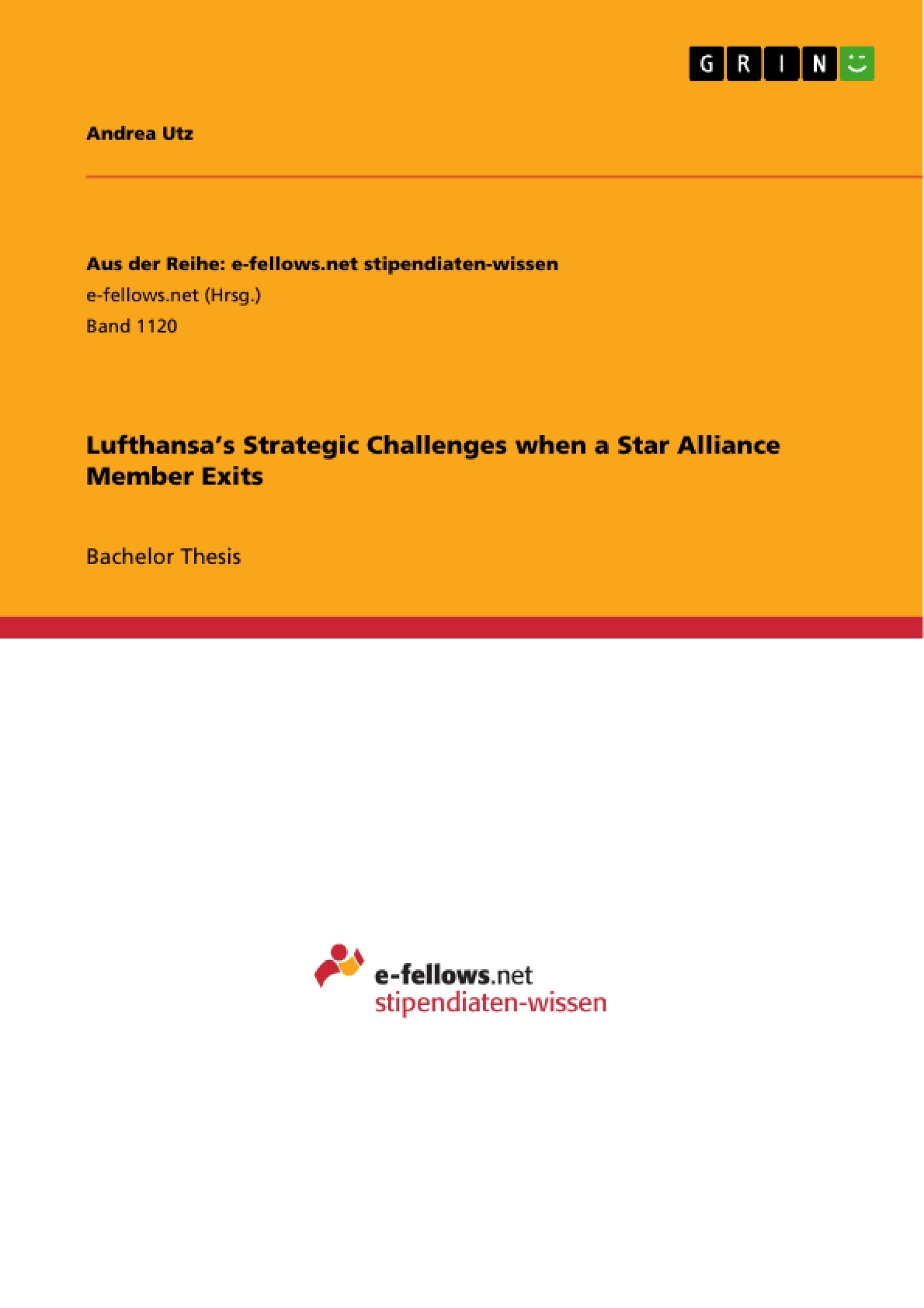The airline sector is a viable and fast changing industry. This became evident especially after the announcement of the fusion between the insolvent company American Airlines and US Airways in February 2013. This begs for the question, how Lufthansa will be affected, as a member of Star Alliance, after the exit of US Airways.
The thesis will analyse Lufthansa’s competitive advantage within the dynamic airline industry based on a strategic analysis of its internal and external environment. Furthermore, with the help of a scenario analysis, potential future situations will be examined and underlined by a management interview given by a CEO from the airline industry. Summing up, even if US Airways exited Star Alliance, it has no substantial influence on the competitive advantage of Lufthansa as a member of Star Alliance.
The study concludes it is very important to find a new partner in order to gain access to the growing emerging markets especially in the Middle East where demand and hubs will grow significantly over the next decades.
Table of Contents
- Introduction: Changes in the Airline Industry.
- Theoretical Framework
- Strategic Management Analysis in a Hypercompetitive Industry
- Hypercompetition.
- External Analysis
- Internal Analysis..........\n
- Building Competitive Advantage
- Business Level Strategy
- Corporate Level Strategy.
- Scenario Analysis with the TAIDA Model
- Scope and Dimensions.
- Scenario Planning with the TAIDA Model.
- Summary
- Empirical Case – Lufthansa's Competitive Advantage
- Strategic Management Analysis in the Hypercompetitive Airline Industry....
- Deregulation of Markets ......
- External Analysis of the Airline Industry..\n
- Internal Analysis of Lufthansa....\n
- Building Competitive Advantage.
- Business Level Strategy of Lufthansa.......
- Corporate Level Strategy of Star Alliance as a Strategic Alliance .....\n
- Summary
- Scenario Analysis..........\n
- Defining Scenarios.....
- Analysing the Four Different Scenarios
- Summary
- Conclusion.......
Objectives and Key Themes
This thesis investigates the competitive advantage of Lufthansa within the dynamically evolving airline industry. It aims to analyze Lufthansa’s internal and external environment to understand how it can achieve and maintain temporary competitive advantage in a hypercompetitive market. The thesis also explores whether Lufthansa’s participation in the Star Alliance contributes to its ability to reach potential customers and generate temporary competitive advantage. A scenario analysis is employed to examine the potential impact of the departure of US Airways from the Star Alliance on Lufthansa’s competitive advantage.
- Competitive Advantage of Lufthansa
- Strategic Management Analysis in the Airline Industry
- Hypercompetition and its Impact on Airlines
- The Role of Alliances in the Airline Industry
- Scenario Analysis of the Star Alliance and Lufthansa's Future
Chapter Summaries
- Introduction: Changes in the Airline Industry. This chapter sets the stage for the thesis by examining the historical development of the airline industry, highlighting its transition from a regulated market to a hypercompetitive environment. It discusses the impact of deregulation on competition, the emergence of low-cost carriers and alliances, and the current state of the industry with a focus on the recent merger of American Airlines and US Airways.
- Theoretical Framework This chapter lays the theoretical foundation for the thesis by introducing the concepts of strategic management analysis in a hypercompetitive industry. It delves into concepts like hypercompetition, external and internal analysis, and building competitive advantage through business level and corporate level strategies. Additionally, it introduces the TAIDA model for scenario analysis.
- Empirical Case – Lufthansa's Competitive Advantage This chapter applies the theoretical framework to Lufthansa, analyzing its competitive advantage in the context of the hypercompetitive airline industry. It examines the factors that have shaped Lufthansa's competitive position, including deregulation, external pressures, and internal strengths. It further investigates Lufthansa's business level and corporate level strategies, including its participation in the Star Alliance.
- Scenario Analysis This chapter delves into a scenario analysis to assess the potential impact of US Airways' departure from Star Alliance on Lufthansa's competitive advantage. It outlines the different scenarios considered, analyzes their implications for Lufthansa, and discusses the strategic adjustments Lufthansa might need to make in response to these scenarios.
Keywords
This thesis explores the competitive advantage of Lufthansa in the hypercompetitive airline industry, focusing on the role of alliances and the potential impact of the US Airways departure from Star Alliance. Key concepts include strategic management analysis, hypercompetition, external and internal analysis, business and corporate level strategies, scenario analysis, and the TAIDA model.
- Quote paper
- Andrea Utz (Author), 2013, Lufthansa’s Strategic Challenges when a Star Alliance Member Exits, Munich, GRIN Verlag, https://www.grin.com/document/292605




